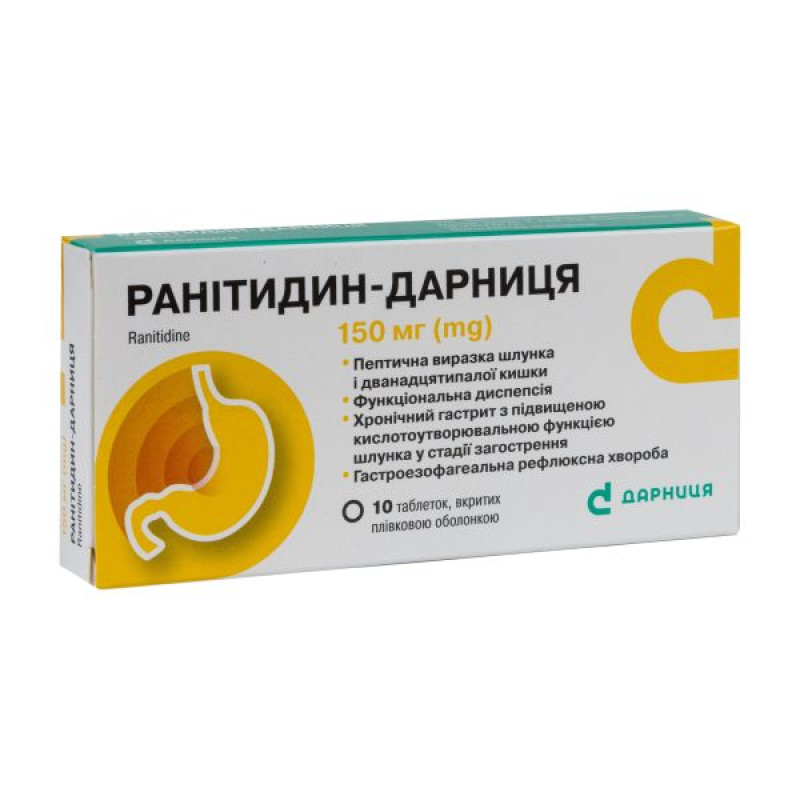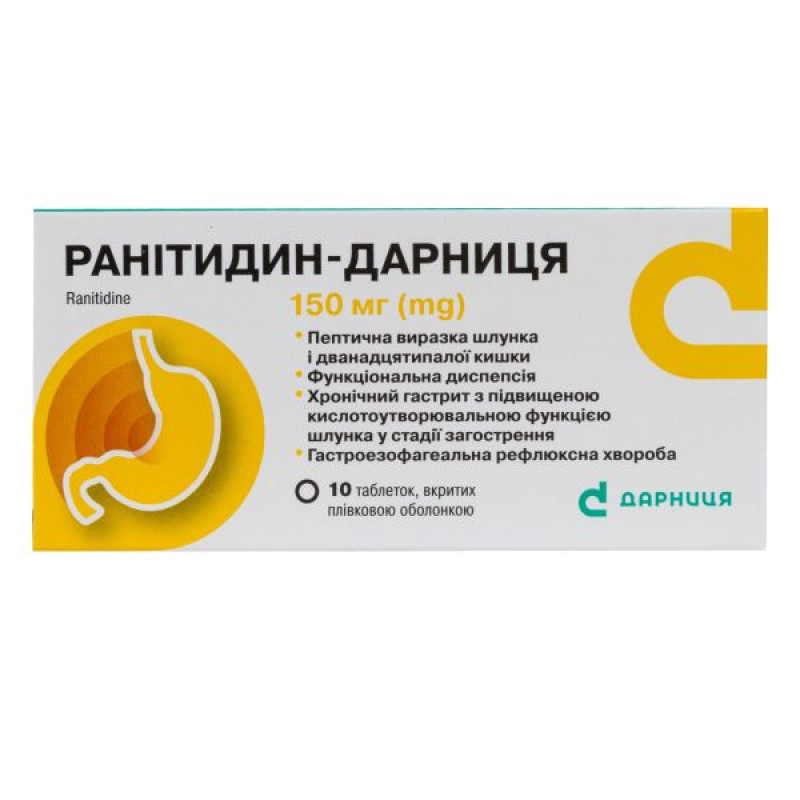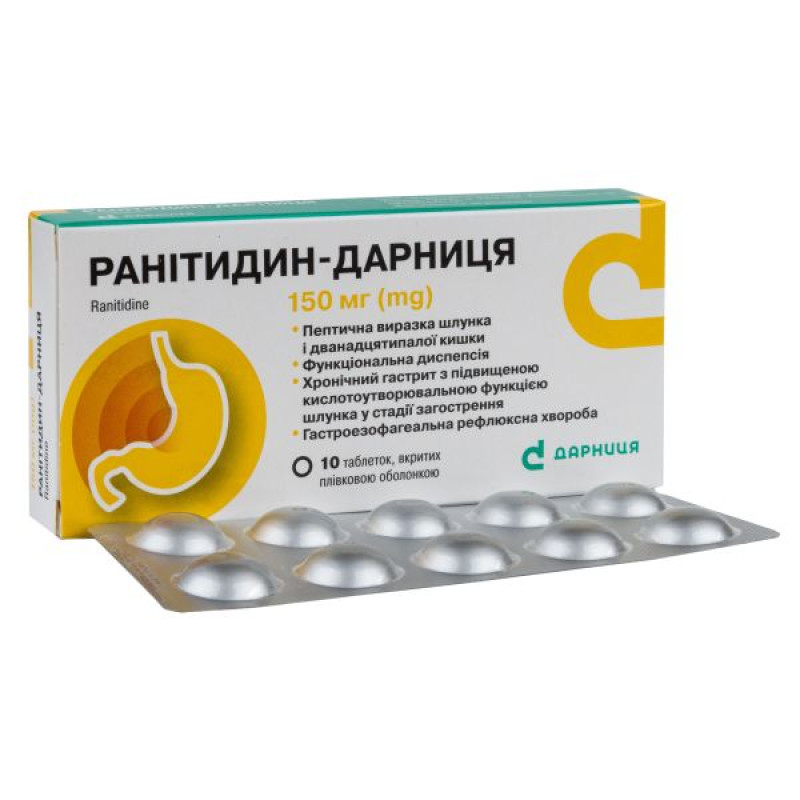Ranitidine-Darnitsa film-coated tablets 150 mg No. 10

Instructions for Ranitidine-Darnitsa film-coated tablets 150 mg No. 10
Composition
active ingredient: ranitidine;
1 tablet contains: ranitidine hydrochloride equivalent to ranitidine 150 mg;
excipients: microcrystalline cellulose, povidone, lactose monohydrate, potato starch, talc, magnesium stearate, Opadry AMV 80 W yellow.
Dosage form
Film-coated tablets.
Main physicochemical properties: round tablets with a biconvex surface, coated, yellow to yellow-orange in color. Two layers are visible on the cross section.
Pharmacotherapeutic group
Drugs for the treatment of peptic ulcer and gastroesophageal reflux disease. H2-histamine receptor antagonists. Ranitidine. ATC code A02B A02.
Pharmacological properties
Pharmacodynamics.
Ranitidine is an antiulcer agent, an antagonist of H2-histamine receptors.
The mechanism of action is due to competitive inhibition of H2-histamine receptors of the parietal cell membranes of the gastric mucosa. Reduces basal and stimulated secretion of hydrochloric acid, reducing the volume of gastric juice caused by irritation of baroreceptors (gastric distension), food load, the action of hormones and biogenic stimulants (gastrin, histamine, pentagastrin, caffeine). Ranitidine reduces the amount of hydrochloric acid in gastric juice, does not affect the concentration of gastrin in blood plasma, as well as the production of mucus. Ranitidine is characterized by a long-lasting effect.
Ranitidine does not affect the cytochrome P450 enzyme system of the liver.
Pharmacokinetics.
After oral administration, ranitidine is rapidly absorbed from the gastrointestinal tract. Bioavailability is about 50%. Peak blood concentrations are reached after 2–3 hours and are 478 ng/ml. It is partially metabolized in the liver to N-oxide (the main metabolite, 4% of the dose), S-oxide and demethylated.
The half-life (after oral administration) with normal creatinine clearance is 2–3 hours, with reduced (20–30 ml/min) – 8–9 hours. Excreted by the kidneys within 24 hours, about 30% of the orally administered dose is excreted unchanged.
Penetrates through histohematological barriers, including the placental barrier, but poorly through the blood-brain barrier. Sufficiently significant concentrations are determined in breast milk. The rate and extent of elimination depend little on the state of the liver and are mainly associated with kidney function.
Indication
Peptic ulcer of the stomach and duodenum, not associated with Helicobacter pylori (in the exacerbation phase), including ulcers associated with the use of non-steroidal anti-inflammatory drugs (NSAIDs);
functional dyspepsia;
chronic gastritis with increased acid-forming function of the stomach in the acute stage;
gastroesophageal reflux disease (to relieve symptoms) or reflux esophagitis.
Contraindication
Increased individual sensitivity to ranitidine and other components of the drug; presence of malignant gastric diseases, history of liver cirrhosis with portosystemic encephalopathy, liver failure, severe renal failure (creatinine clearance < 30 ml/min).
Interaction with other medicinal products and other types of interactions
Ranitidine may affect the absorption, metabolism and renal excretion of other drugs.
Ranitidine in therapeutic doses does not change the activity of the cytochrome P450 enzyme system and does not potentiate the effect of drugs metabolized by this system (diazepam, lidocaine, phenytoin, propranolol, theophylline).
Ranitidine, by altering gastric acidity, may affect the bioavailability of some drugs. This leads to either increased absorption (triazolam, midazolam, glipizide) or decreased absorption (ketoconazole, itraconazole, atazanavir, gefitinib).
Antacids and sucralfate slow down the absorption of ranitidine, as a result of which the interval between taking these drugs and ranitidine should be at least 1–2 hours.
Concomitant use with metoprolol may lead to increased serum concentrations of metoprolol.
Ranitidine, when used simultaneously with coumarin anticoagulants (warfarin), may alter prothrombin time (monitoring of prothrombin time is recommended).
Large doses of ranitidine may slow the excretion of procainamide and N-acetylprocainamide, leading to increased plasma levels.
There are no data on the interaction between ranitidine and amoxicillin or metronidazole.
Tobacco smoking reduces the effectiveness of ranitidine.
Application features
If you are allergic to other drugs in the group of histamine H2 receptor blockers, allergic reactions to ranitidine are possible, therefore, if you are hypersensitivity to other drugs in this group, the drug should be used with caution.
Use the drug with caution in acute porphyria (including a history), immunodeficiency, and phenylketonuria.
Elderly patients with impaired liver or kidney function may experience impaired consciousness (confusion), which necessitates a dose reduction.
Treatment with ranitidine may mask the symptoms of gastric carcinoma, therefore, before starting treatment, the presence of malignant neoplasms in the stomach should be excluded.
Regular monitoring is necessary for patients (especially the elderly and those with a history of peptic ulcer of the stomach and/or duodenum) taking ranitidine together with NSAIDs.
With simultaneous treatment with theophylline, it is necessary to monitor the plasma level of theophylline and adjust the dosage.
Elderly patients, those with chronic lung disease, diabetes, or those with weakened immune systems have been observed to be at increased risk of developing community-acquired pneumonia.
Ranitidine treatment should be discontinued gradually due to the risk of rebound syndrome with abrupt discontinuation.
Ranitidine should not be used in patients with liver failure.
Important information about excipients.
The medicinal product contains lactose, which should be taken into account in patients with rare hereditary forms of galactose intolerance, lactase deficiency, or glucose-galactose malabsorption syndrome.
If the patient has been diagnosed with an intolerance to some sugars, contact your doctor before taking this medicinal product.
Use during pregnancy or breastfeeding
The drug is contraindicated during pregnancy.
If necessary, use of the drug should stop breastfeeding.
The ability to influence the reaction speed when driving or working with other mechanisms
Considering that sensitive patients may experience adverse reactions (dizziness, hallucinations, accommodation disorders) when using the drug, you should refrain from driving vehicles or working with other mechanisms while taking the drug.
Method of administration and doses
For adults and children over 12 years of age. Take orally, without chewing, with a small amount of water, regardless of meals.
Peptic ulcer of the stomach and duodenum, not associated with Helicobacter pylori (in the acute phase). Prescribe 150 mg (1 tablet) 2 times a day in the morning and evening or 300 mg (2 tablets) once at night for 4 weeks. For ulcers that have not healed, continue treatment for another 4 weeks.
Prevention of peptic ulcer of the stomach and duodenum associated with taking NSAIDs. Prescribe 150 mg (1 tablet) 2 times a day in the morning and evening for the period of NSAID therapy.
Functional dyspepsia. Prescribe 150 mg (1 tablet) 2 times a day in the morning and evening for 2–3 weeks.
Chronic gastritis with increased acid-forming function of the stomach in the acute stage. Prescribe 150 mg (1 tablet) 2 times a day in the morning and evening for 2–4 weeks.
Gastroesophageal reflux disease. To relieve symptoms, prescribe 150 mg (1 tablet) 2 times a day in the morning and evening for 2 weeks; if necessary, continue the course of treatment.
For long-term treatment and in case of exacerbation of gastroesophageal reflux disease, prescribe 150 mg (1 tablet) 2 times a day in the morning and evening or 300 mg (2 tablets) once a day at night for 8 weeks; if necessary, extend the course of treatment to 12 weeks.
Patients with severe renal insufficiency (creatinine clearance less than 50 ml/min). The daily dose of the drug for this category of patients is 1 tablet (150 mg of ranitidine).
Children
In children aged 12 years and over, the use of the drug is indicated to shorten the treatment period for peptic ulcer of the stomach and duodenum, for the treatment of gastroesophageal reflux disease, including reflux esophagitis, and to relieve the symptoms of gastroesophageal reflux disease.
Overdose
Possible increase in adverse reactions.
Treatment: if necessary, conduct adequate symptomatic and supportive therapy.
Ranitidine can be removed from serum by hemodialysis.
Side effects
On the part of the organs of vision: blurred visual perception, accommodation disorders.
Gastrointestinal: dry mouth, nausea, vomiting, constipation, diarrhea, abdominal pain, flatulence, acute pancreatitis, decreased appetite, lack of appetite.
Hepatobiliary disorders: transient and reversible changes in liver function tests (transaminases, gammaglutamyltransferase, alkaline phosphatase, bilirubin), hepatocellular, cholestatic or mixed hepatitis with or without jaundice (usually reversible).
Renal and urinary disorders: renal dysfunction, acute interstitial nephritis, increased plasma creatinine levels.
Nervous system: headache (sometimes severe), dizziness and reversible involuntary movement disorders.
Cardiovascular system: decreased blood pressure, bradycardia, tachycardia, asystole, atrioventricular block, vasculitis, chest pain, arrhythmia, extrasystole.
Blood and lymphatic system disorders: leukopenia, reversible thrombocytopenia, agranulocytosis or pancytopenia, sometimes with bone marrow hypoplasia or aplasia, neutropenia, immune hemolytic and aplastic anemia (usually reversible).
On the part of the immune system: hypersensitivity reactions, including urticaria, angioedema, anaphylactic shock, bronchospasm, erythema multiforme exudative, exfoliative dermatitis, Stevens-Johnson syndrome, toxic epidermal necrolysis (Lyell's syndrome), hyperthermia.
Skin and subcutaneous tissue disorders: hyperemia, itching, skin rashes, erythema multiforme, alopecia, dry skin.
Musculoskeletal and connective tissue disorders: arthralgia, myalgia.
From the reproductive system and mammary gland function: hyperprolactinemia, galactorrhea, gynecomastia, amenorrhea, decreased potency (reversible) and/or libido.
General disorders: fever.
Reporting of suspected adverse reactions.
Reporting suspected adverse reactions after the marketing authorisation of a medicinal product is an important procedure. It allows for continued monitoring of the benefit-risk balance of the medicinal product in question. Healthcare professionals should report any suspected adverse reactions via the national reporting system.
Expiration date
2 years.
Storage conditions
Store in original packaging at a temperature not exceeding 25 ° C. Keep out of the reach of children.
Packaging
10 tablets in a contour blister pack; 1 or 2 contour blister packs in a pack.
Vacation category
According to the recipe.
Producer
PrJSC "Pharmaceutical Company "Darnitsa".
Address
Ukraine, 02093, Kyiv, Boryspilska St., 13.
There are no reviews for this product.
There are no reviews for this product, be the first to leave your review.
No questions about this product, be the first and ask your question.










